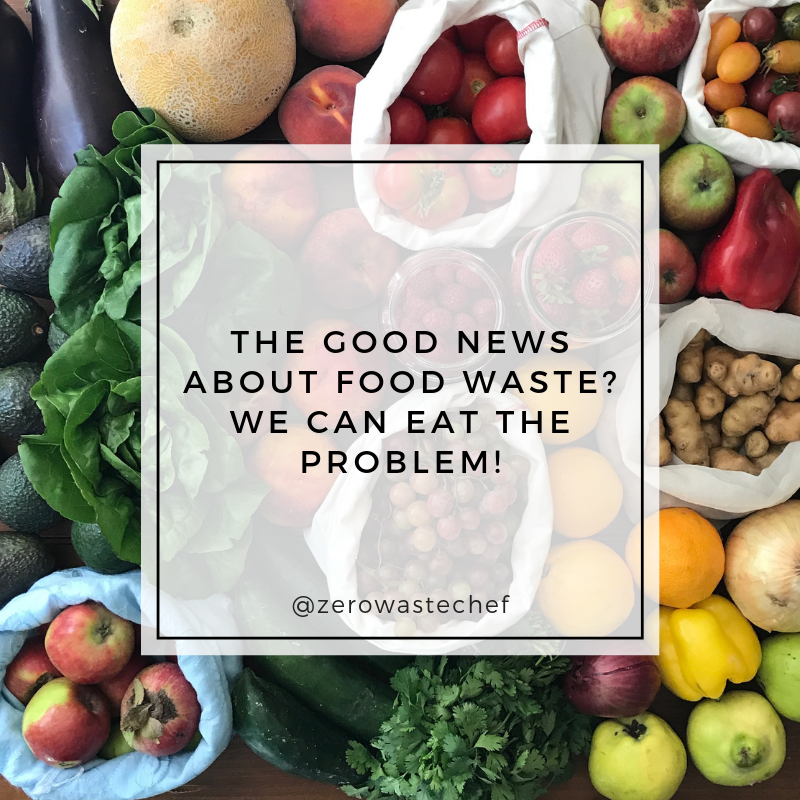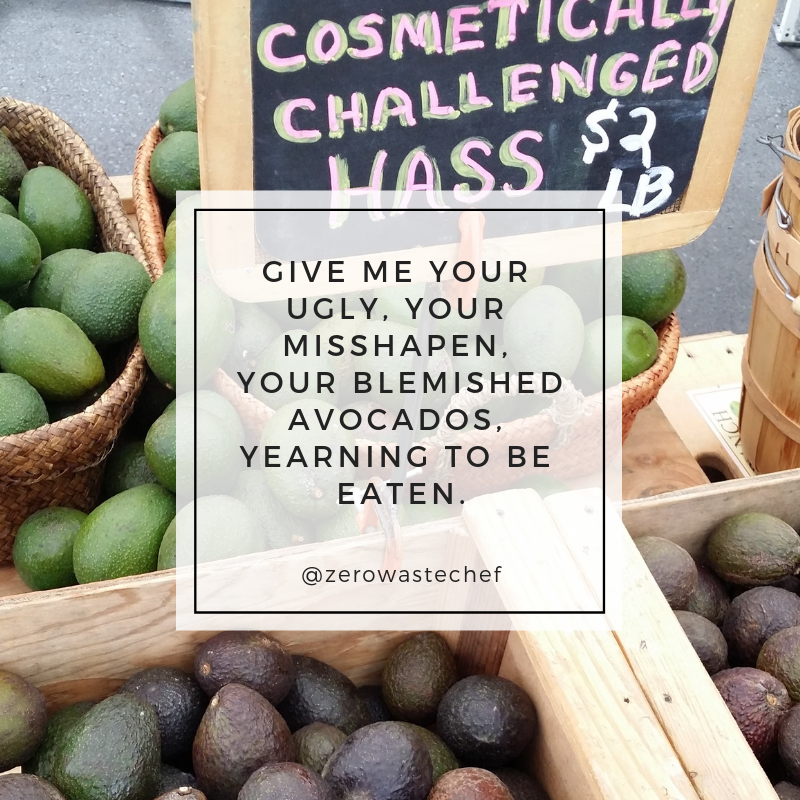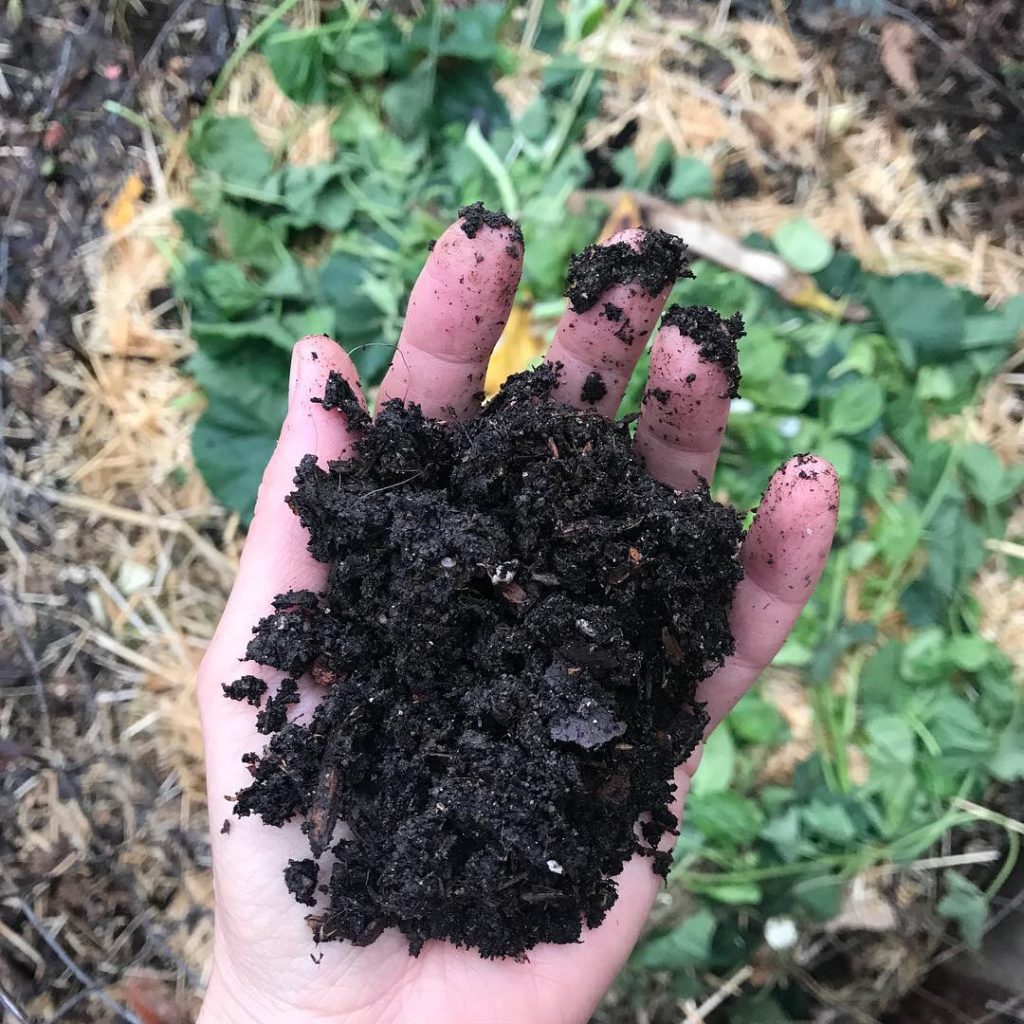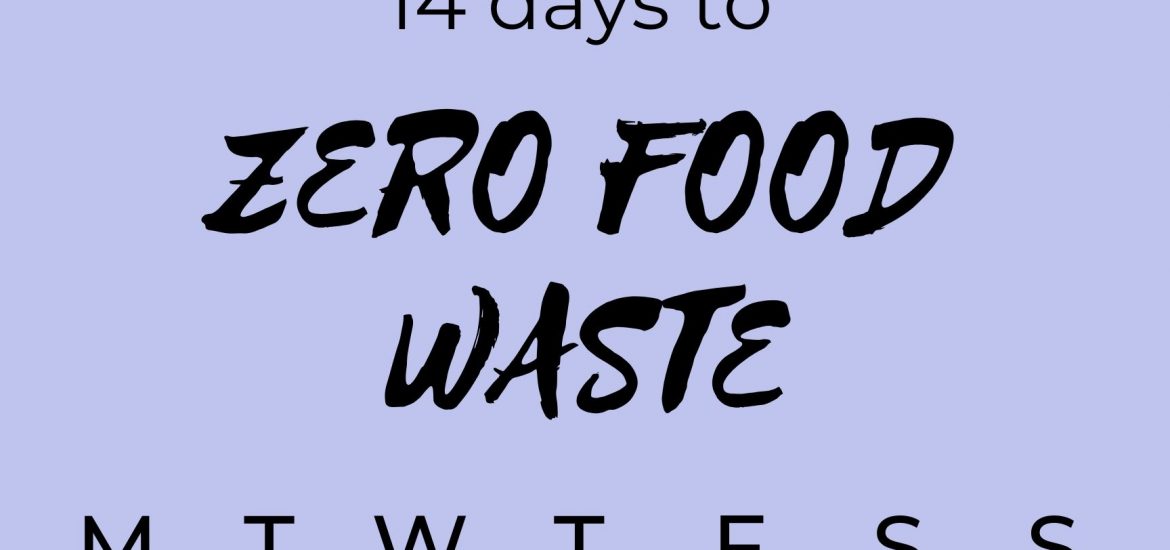No doubt you’ve heard some of the shocking food waste statistics and if you have not, well, rest assured we will move on to some solutions for this problem right after we get the bad news out of the way.
- Up to 40 percent of the food we produce in the US goes uneaten. National Resources Defense Council
- Americans waste nearly one-third of the food they buy. American Journal of Agricultural Economics
- If food waste were a country, it would be the third largest emitter of greenhouse gases, just behind the US and China. Project Drawdown

I had a great response to my challenge, Go Zero-Waste in 31 Days, which I posted this past January and promoted again on social media in March and May (also 31-day months). Many of you have told me that you found that challenge helpful and fun and for several months now, I’ve wanted to create a similar challenge to tackle food waste. So here it finally is!
You’ll find most of these daily accomplishments pretty simple and by the end of the challenge, you’ll have practiced 14 tactics to drastically reduce food waste—and save money!
If you take the challenge and post about it on Instagram, please use the hashtag #ZeroFoodWasteChallenge. I’d love to see your progress and the dishes you come up with!
Day 1 Cook a clear-out-the-pantry dish
To kick things off, you’ll cook yourself a dish without buying any new ingredients. You could make something as simple as oatmeal for breakfast with dried fruit and seeds you may have hidden away in the pantry; a vegetable salad with leftover protein tossed in and dressed with lemon juice and olive oil for lunch; or bread pudding for dessert, made from a stale loaf.
Go here for use-it-up recipe ideas that you can adjust according to the food you have on hand.
Day 2: Hoard glass jars for food storage and well, everything
If you’ve been on the zero-waste path for even a short while, you may already have developed a jar addiction. If you’ve just begun, start hoarding glass jars now. You’ll use them for everything. Ask friends and neighbors for theirs. My daughter MK works in restaurants in the summers and brings home the best jars. Restaurants, cafés and bars would rather give their jars away than recycle or toss them. Ask around!
Jars solve so many problems. When you store food in them, you can see at a glance what you have on hand in the cupboards and the refrigerator. Take one or two to restaurants as well when you eat out. The opaque containers restaurants hand out for leftovers conceal their contents. If you can’t see inside the container, you’ll likely forget about that Chinese food in the corner of the refrigerator until it has started to break down into goop.
I also freeze food in glass and you can read about that here. To learn how to remove labels from jars and smells from lids, go here.

Day 3: Take stock of your kitchen inventory
If you know what food is on hand, more likely it will fill tummies, not trash. So jot down what you have in the following categories:
- Vegetables
- Fruit
- Protein
- Dairy
- Grains
- Other
In addition to the types of foods you find, you could also list the amounts and when you need to use them up by. But you don’t need to get too elaborate unless you’d like to. Note your inventory on a device, a kitchen chalkboard or a paper on the refrigerator.
Before you shop next, you’ll have a better idea of what you need which will help you avoid buying too much food. Overbuying, especially overbuying fresh produce, leads to food going to waste—and money too!
Day 4: Do some simple meal planning
Like all things zero-waste, a plan helps you reach your goals. You don’t need to create a complicated Excel spreadsheet detailing every morsel you’ll consume for the week—but by all means do so if you want to—just create a simple plan for the next few days to a week. Keep a couple of slots blank for the unexpected—a last-minute dinner invitation, a catered lunch at the office, your kids eating at a friend’s house.
With your kitchen inventory in hand, figure out what meals you can cook with ingredients you already have. Do this before shopping for more food and you’ll basically eliminate food waste at home. Make a list of missing ingredients for the dishes you want to cook.
Go here for easy, four-step meal planning.
Day 5: Buy less food, the easiest way to avoid food waste
With your kitchen inventory and meal plan completed, it’s time to go grocery shopping. Many of us overestimate how much of each type of food we need and how much each of our diners will actually eat. If you want to roast a side dish of potatoes for only two people, for example, do you really need five pounds of spuds?
If you’re unsure about how much food you’ll need, check out the Guestimator, a dinner party planning tool from Save the Food. The first time I tried it, I was surprised by how little food I needed to buy for some of the dishes I had planned to serve. Use this fun tool any time, not only for planning dinner parties.
Day 6: Choose ugly fruit and vegetables
The rigid requirements of many grocery stores for fruit and vegetables of a uniform size, with a perfect shape and color, result in many overlooked and uneaten “uglies” heading to the landfill. If you shop at the farmers’ market, you’ll find bins and bins overflowing with wonky looking—and utterly delicious—produce because that’s how food grows. Reject unrealistic ideals of vegetable beauty! Buy wonky if you can in your area. Some farmers at my market offer a discount for not-so-pretty apples, avocados and peaches.
You can find ugly fruit and vegetables for a discount elsewhere as well—but with some packaging. Grocery chain Kroger apparently will sell ugly fruit and vegetables later this year. Companies like Imperfect Produce, Hungry Harvest and Eat Misfits all deliver ugly fruit and vegetable boxes.

Day 7: Prep after you shop
If I do some prep on Sunday afternoon, my week goes much smoother. When I want to cook a dish, I grab out of the refrigerator the cooked beans, the trimmed and washed leafy greens, the roasted squash or the homemade broth. On busy weeknights after a long day, with several components of a dish prepped and ready to go, I can make a meal quickly, resisting the urge to order takeout, guaranteeing we eat the food we have on hand.
Day 8: Store food properly
Make food last by storing it in the right place. Store tomatoes on the counter—they become mealy and tasteless stored in the refrigerator. Basil keeps well on the counter also, stored in a jar of water, as does asparagus. Potatoes and onions keep better when kept away from each other. On the other hand, if you want to speed up the ripening of an avocado, store it in a bowl of fruit. The ethylene gas from the fruit will cause the avocado to ripen quickly.
When in doubt, separate fruit and vegetables and keep bananas away from everything. Go here for an A to Z list on storing produce without plastic.
Day 9: Use up every bit of produce
Never shell out money for vegetable broth again! When I prep vegetables for dishes, I save the little bits and store them in the freezer until I have amassed enough to make broth. The pot below contains butternut squash peels, bits of celery, carrot, onion and mushroom, a small hunk of broccoli, a few bits of tomato, and several jalapeño ends which add amazing flavor.
Other good choices for broth include the tails of green beans, bits of bell peppers, pea pods, parsnips, the hard ends of asparagus, corn cobs (so much flavor!), garlic and zucchini. Herbs taste delicious but add small amounts so as to not overpower the flavor of the broth. Use only small amounts of bitter greens and carrot tops as well.
I buy organic vegetables and so don’t worry about pesticides in the skins and peels of the vegetables in my broth. Check out the dirty dozen list from EWG here to determine which vegetable peels you might want to avoid in your broth. A baking soda and water wash can remove some pesticides from produce. Read about that here.
Just barely cover the vegetable scraps with water in a pot, put a lid on it, bring to a boil, remove the lid, turn down the heat and simmer the vegetable scraps for about 20 minutes. Strain and either use immediately, store in the refrigerator for a week or so, or freeze in either ice cube trays or wide-mouth glass jars.
I sometimes hear the argument that zero waste costs too much money. I save a bundle. Simple tricks like this broth are one reason why. Good chefs use up every last scrap of food—but only if they want to stay in business. Think of your kitchen the same way. Every bit of food waste you prevent keeps money in your bank account (or under your mattress if you prefer).
Go here for more ideas for cooking with food scraps.
Day 10: Preserve something
If you find you have extra food you won’t eat soon, you can try preserving it to make it last. A few methods to choose from:
- Easy: Freeze it. If you won’t finish the leftover pasta sauce before it turns, put it in the freezer. Keep it there for a few days, a few weeks or longer. Read about freezing food without plastic here.
- Still pretty easy: Cook it and freeze it. Have some vegetables that you won’t eat this week? Roast them and freeze them or purée them into a soup, sauce or a dip and freeze that. Every summer I roast boxes of tomatoes and freeze them so we’ll have tomatoes in winter. Read more about that here.
- More advanced but also easy: Ferment vegetables. Have a head of cabbage you wont get to? Grate it, salt it, pack it in a jar and let it sit for a few days on the counter. You’ll have delicious probiotic sauerkraut that keeps for months in the refrigerator. Find the basic sauerkraut recipe here.
Day 11: Give food away before it can become food waste
Have too much food on your hands and want to avoid food waste quickly and easily? Share your food! Ask your friends and family if they’d like it or post it on the OLIO app. People in your area who use the app will see it and take it off your hands—often very quickly.
I’ve seen all sorts of delicious food posted on OLIO—fresh produce like bell peppers, oranges, apples, corn on the cob, cucumbers, lettuce and so much more; bagels, bread and other baked goods; even water kefir grains! It costs nothing to use the app—whether you post or eat.
Day 12: Watch a documentary on food waste
Everyone who eats should watch the documentary Wasted! The Story of Food Waste. Produced by the late great Anthony Bourdain, it features renowned chefs Dan Barber, Mario Battali, Massimo Battura and Danny Bowien. View the trailer below.
You’ll feel inspired to reduce food waste after you watch this uplifting documentary.
Day 13: Reduce food waste when you dine out
It’s the weekend! If you eat out this weekend (or any time), you can reduce food waste on the go as well. Many restaurants both here in the US and abroad offer portions that could feed a couple of people. To reduce food waste, you could split an entrée with your dining partner when you eat out, bring a glass jar or container for the leftovers—or do both.
When you bring your own container, you also avoid the dreaded should-I-waste-the-disposable-restaurant-container-or-waste-the-food dilemma. After eating at our favorite Indian restaurant, my younger daughter loves packing the leftovers in her lunch for school.
Day 14: Stealthily recruit others
Your family, friends—and especially acquaintances—don’t want to hear you say “You should stop wasting so much food. Since when do you have so much money that you can afford to essentially throw a bunch away? I thought you were still unemployed.”
You know what does work? “I made this fruit crumble with strawberries that I noticed were getting soft. Here, try some.” Create awareness through desserts.

Bonus crucial step: Compost food waste as a last resort
Ideally, we would not waste food but waste happens. You get sick and can’t eat, your kids eat at their friends’ houses and come home full or you buy too much food. Wasted food belongs in a compost bin, not a landfill.
Compacted in a landfill, food lacks exposure to oxygen and so breaks down anaerobically, releasing methane gas into the atmosphere, a greenhouse gas 34 times more potent than carbon dioxide over time, according to Drawdown.
On the other hand, when that same food waste (and food scraps) breaks down in a compost bin, it actually draws carbon dioxide out of the atmosphere.
If you have a patch of dirt in your yard, you can start composting today. Collect your food scraps—fruit and vegetable peels, scraps of food your kids didn’t finish at lunch, moldy produce—in a large container and toss them on the ground at the end of the day. Cover them with brown matter (dry leaves for example). Tomorrow, repeat. Or add scraps every few days. Go here for more on lazy composting.
Live in a cold climate? My sister composts year round in the Great White North. She tosses her scraps on her compost heap outside. They freeze. They thaw. They rot.
If you live in an apartment and have no yard, consider starting a worm bin—or vermicompost. You’ll keep a bin of red worms in a convenient location and feed them your food scraps. They’ll produce earthy-smelling, nutrient-rich material that you can add to houseplants or give to gardening friends.
If you can’t compost at home, look for facilities near you through your city. Also check out ShareWaste, and Airbnb-like app for food scraps. You search the ShareWaste map for people accepting compost scraps where you live—or where you will be traveling to—and then you drop them off. Or you sign up to accept food scraps. All free, all volunteer run. This is the real sharing economy!

Find more tips and recipes in my cookbook to help you reduce wasted food. It is a finalist for a cookbook award from the International Association of Culinary Professionals and has been shortlisted for a Taste Canada award!





One problem I’ve encountered when saving glass jars is how to remove the odor from the lids, such as pickle brine. Yes, I already use the brine for yummy hard-cooked eggs, but after the brine is exhausted haven’t been successful using the jar for other purposes.
Hi Zena,
A few years ago I discovered the BEST cure for this problem: the sun. Put the lids out in direct sun, stinky side up, and it will eliminate the pickle smell. The first time I tried this, I was blown away. It works much better in summer, so if you are in the Northern Hemisphere like me, you should be all set. I even once removed the smell from a jar my boss gave me that had contained minced garlic :O That one took a few days but it finally worked!
~ Anne Marie
Oh, thank you so much! Glass jars are a precious commodity & I don’t want to waste even one.
SUCH a great post! I will aim to share it to my blog soon- such good practical tips 😊
Thank you, thank you! I’m glad you like the tips!
~ Anne Marie
Thank you for so many great ideas, I really enjoy your posts.
I’m working on being less wasteful, it’s especially rewarding to make a great meal out of “nothing” 😊
aRe YoU mY mOm???!!
Amazing list! thank you so much, I’m definitelly going to try thses! Oh and I absoluely love OLIO!!! <3 Everyone please get on there so we can share not waste!
One tool I find really useful is ‘Consciously Planning To Finish What I Start’ – basically if I use part of something that is likely to perish within a few days if not eaten, I try to make a plan there and then about how and when I am going to use the remainder of it rather than just leaving it to chance. Has saved no end of hummus, vegan yogurt etc. from the bin that would otherwise have got forgotten until it was too late.
Hi! I think I am having problem with olioex.com website. Keep getting the message (regardless of browser) that it is insecure and someone has malicious intentions…etc. Anyone have similar experience? Recommendations? Will try the restart and try again routine, but wanted to make a note here in case others are having issue.
Ciao
Your posts always have so many practical tips in them, love it. We very rarely have food waste but I love the idea of a clear out the pantry dish!
Hi!
So happy IG suggested me you!
I start my Zero 7 days without plastic and I have my first problem: wash my clothes, was my dishes!
What do you use as 🧼 ?
And I am preparing my 42 yo birthday (next 8th of June) I challenged myself to make a ‘Zero waste Bday’ and I need 25-30 champagne glasses…and nobody hasn’t.
Buy such quantities of glass of champagne it is also not planet save, plastic is not in my options 🙂 and drink directly from the bottle not really enthusiastic! Ahahaha so…pls, do you have better ideas
I really thank you for your tips and advice!
with my best regards
Wow really has me inspired and entertained
[…] #meiplasticvrij lanceert de zero waste chef alweer een nieuwe uitdaging: 14 days to Zero Food Waste oftewel in 14 dagen minder […]
Hi! I’m so happy I came across your blog, especially this post 🙂 I’ve been on quite the journey the past few years with the goal to minimize my plastic waste (and all other trash) but I never really thought about food waste. I will certainly use these tips to live more sustainable in that area as well 🙂
[…] great article and blog, will help you reduce your waste and get you thinking of other small ways you can help the […]
[…] all know why it’s good for us to eat fruits and vegetables, but what’s so important about low-waste cooking? Did you know that U.S. households toss out about 150 tons of food daily? The items most likely to […]
[…] waste exists within a larger environmental and social imperative. To get started, take her 14- day zero food waste challenge and review her 50 tips for going waste […]
[…] sabemos por que é bom comer frutas e legumes, mas o que é tão importante cozimento com baixo desperdício? Você sabia que as famílias dos EUA jogue fora cerca de 150 toneladas de comida diariamente? Os […]
[…] all know why it’s good for us to eat fruits and vegetables, but what’s so important about low-waste cooking? Did you know that U.S. households toss out about 150 tons of food daily? The items most likely to […]
[…] know why it’s good for us to eat fruits and vegetables, but what’s so important about low-waste cooking? Did you know that U.S. households toss out about 150 tons of food daily? The items most likely to […]
[…] We can reduce our food waste by purchasing only the food we need and using what we have, saving and eating leftovers. For some great inspiration, the Zero Waste Chef has a 14 days to zero food waste challenge. […]
Awesome blog you have heere
Thank you!